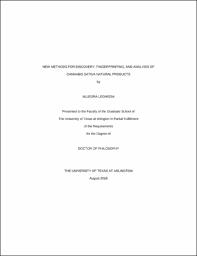
ATTENTION: The works hosted here are being migrated to a new repository that will consolidate resources, improve discoverability, and better show UTA's research impact on the global community. We will update authors as the migration progresses. Please see MavMatrix for more information.
Show simple item record
| dc.contributor.advisor | Schug, Kevin A. | |
| dc.creator | Leghissa, Allegra | |
| dc.date.accessioned | 2019-08-29T20:43:11Z | |
| dc.date.available | 2019-08-29T20:43:11Z | |
| dc.date.created | 2018-08 | |
| dc.date.issued | 2018-08-27 | |
| dc.date.submitted | August 2018 | |
| dc.identifier.uri | http://hdl.handle.net/10106/28646 | |
| dc.description.abstract | Cannabis sativa is an herbaceous annual that has always been of great interest due to its uses in the manufacturing of textiles and cordage, as well as for its medicinal properties. The two main bioactive components of C. sativa are cannabinoids and terpenes; the former confer the medicinal and pharmaceutical benefits, as well as the psycho-activity, to the plant, while the latter are largely responsible for aroma and flavor. Because of the importance of both sets of analytes, it is crucial to have a comprehensive understanding and characterization of these compounds, and different methods have been developed to address these different objectives.
Two methods were developed for the analysis of cannabinoids using gas chromatography (GC), coupled either with mass spectrometry (MS), or with the vacuum ultraviolet detector (VUV). The first method uses tandem mass spectrometry (MS/MS) for the analysis of cannabinoids, which may exist as trace components in C. sativa products. That methodology may also be used as a tool for the discovery of new species, due the combination of high sensitivity and the availability of common fragmentation pathways. Multiple reaction monitoring (MRM) mode, which allows the selection of a precursor and a
vii
product ion for each transition, was used to attain the highest specificity and sensitivity possible for the method. A greater sensitivity is achieved even if the signal of each peak is lower than in scan mode, because there is almost no background noise detected in MRM mode.
The second methodology developed featured the vacuum-ultraviolet detector (VUV) for the quantification of the eight most abundant cannabinoids, which can be found in different specimens. For both MS and VUV detection, relatively fast separations were achieved, but samples needed to be derivatized prior to analysis to avoid the degradation of Δ9-tetrahydrocannabinolic acid (Δ9-THCA) into Δ9-tetrahydrocannabinol (Δ9-THC); other cannabinoid acids would have a similar fate. These two instruments were also used to develop methods for the analysis of Δ9-THC metabolites in urine and plasma. Metabolite analysis is important because cannabinoids are broken down into other molecules inside our body, and such molecules can also have unique physiological effects.
Terpenes were also analyzed by GC-VUV, using a headspace extraction method featuring a hydrophilic room temperature ionic liquid (RTIL) co-solvent. This new technique was created and validated using hops, due to their similar matrix to C. sativa, and it has shown to be more efficient that normal solvent extraction. The main advantages are given by the elimination of matrix components of the plant, giving a cleaner and easier to understand chromatogram.
Finally, a comparison among the different fragmentation pathways that cannabinoids undergo in the MS was drawn between different ionization sources (electron ionization (EI), electrospray ionization (ESI), and atmospheric pressure chemical ionization (APCI)) and in subsequent tandem mass spectrometry fragmentation experiments. Similar or identical pathways were highlighted for different cannabinoids with different sources. | |
| dc.format.mimetype | application/pdf | |
| dc.language.iso | en_US | |
| dc.subject | Cannabis sativa | |
| dc.subject | Gas chromatography | |
| dc.subject | Mass spectrometry | |
| dc.subject | Vacuum ultraviolet spectroscopy | |
| dc.subject | MRM | |
| dc.subject | Absorbance | |
| dc.subject | Metabolites | |
| dc.title | NEW METHODS FOR DISCOVERY, FINGERPRINTING, AND ANALYSIS OF CANNABIS SATIVA NATURAL PRODUCTS | |
| dc.type | Thesis | |
| dc.degree.department | Chemistry and Biochemistry | |
| dc.degree.name | Doctor of Philosophy in Chemistry | |
| dc.date.updated | 2019-08-29T20:43:12Z | |
| thesis.degree.department | Chemistry and Biochemistry | |
| thesis.degree.grantor | The University of Texas at Arlington | |
| thesis.degree.level | Doctoral | |
| thesis.degree.name | Doctor of Philosophy in Chemistry | |
| dc.type.material | text | |
Files in this item
- Name:
- LEGHISSA-DISSERTATION-2018.pdf
- Size:
- 2.752Mb
- Format:
- PDF
This item appears in the following Collection(s)
Show simple item record


